Bowithick Quarry is a disused nineteenth century open cast slate quarry situated in Trebarwith Valley on the outskirts of Tintagel in Cornwall, South West England. The quarry ceased operations in 1913.
The quarry site lies in Trebarwith valley between the hamlets of Trewarmett and Penpethy and can be accessed from the B3263 road.
Bowithick quarry lies at the eastern end of the Prince of Wales Quarry and the two appear to have been worked in tandem. Slate from both quarries was dressed at Bowithick with the finished stone being hauled back across the valley using power from the Woolf Compound beam engine located at the Prince of Wales quarry. The slate travelled across the road by bridges which are no longer standing. There are traces of a steam winding engine house at Bowithick. The quarry ceased operations in around 1913. [1]
The quarry is now mostly obscured by a landfill site.
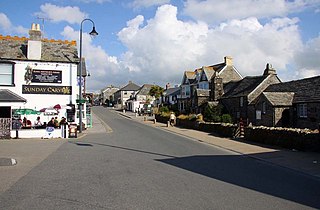
Tintagel or Trevena is a civil parish and village situated on the Atlantic coast of Cornwall, England, United Kingdom. The village and nearby Tintagel Castle are associated with the legends surrounding King Arthur and in recent times have become a tourist attraction. It was claimed by Geoffrey of Monmouth that the castle was an ancient residence of King Arthur.

North Cornwall is an area of Cornwall, England, United Kingdom. It is also the name of a former local government district, which was administered from Bodmin and Wadebridge 50.516°N 4.835°W. Other towns in the area are Launceston, Bude, Padstow, and Camelford.

Treknow is a small village in Tintagel civil parish, Cornwall, England, United Kingdom: it is the second largest settlement, and is located between Trevena and Trebarwith. It is situated 19 miles (31 km) north of Bodmin, 4 miles (6.4 km) north-west of Camelford, and 1 mile (1.6 km) west of Tintagel, grid reference SX056869
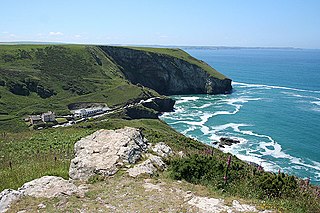
Trebarwith Strand is a section of coastline located near the coastal settlement of Trebarwith on the north coast of Cornwall, England, UK, 2+1⁄2 miles (4.0 km) south of Tintagel. It has 800m of sandy beach contained by cliffs in which natural caves are found. The beach can only be accessed at low tide. The strand was once used to land ships to export slate from the nearby quarries while sand from the beach was used for agricultural purposes. The view from the beach is dominated by rocks 300m offshore known as Gull Rock or Otterham Rocks.

The Eglwyseg valley is an area to the north east of Llangollen in Denbighshire, Wales; it is within the boundaries of Llantysilio Community. The name also refers to a widely scattered hamlet in the valley.
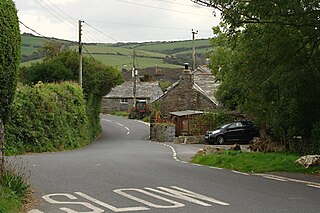
Trewarmett is a small hamlet in Cornwall, England, United Kingdom. It lies within the civil parish of Tintagel, 3 miles (5 km) north-west of Camelford. To the west of Trewarmett is Trebarwith Nature Reserve.

Graig Ddu quarry is a disused slate quarry near Blaenau Ffestiniog, in Gwynedd, North Wales. Although output was only about 3,000 tons a year, it reputedly has 36 saw tables and the same number of dressing machines on site. As with others in the area, the quarry suffered from a lack of water, resulting in the siting of the mill some distance away, at a lower level.

Wrysgan quarry was a slate quarry near the village of Tanygrisiau, Blaenau Festiniog, North Wales. It was worked intermittently from the 1830s, and was worked continuously from c.1850 until 1946. Wrysgan was an underground slate quarry, which was located on a small inaccessible site, some 1,390 feet (420 m) above sea level, to the west of Cwmorthin.

The Prince Llewellyn quarry was a slate quarry that stands on the west side of the Lledr Valley, ENE of Dolwyddelan. It was worked from around 1820 to 1934.
Chwarel Ddu quarry was the earliest slate quarry in the Lledr Valley. It was working before 1810, and continued in sporadic operation until the late 1920s. It is about 0.5 miles (0.80 km) west of Dolwyddelan, just beneath Dolwyddelan Castle.
Gillow State Quarry is a small, disused slate quarry between Tintagel and Trebarwith on the north coast of Cornwall, South West England. The quarry was abandoned by the turn of the 20th century.
Long Grass Quarry is a small, disused slate quarry between Tintagel and Trebarwith on the north coast of Cornwall, South West England, which was worked up until 1937. It was the last of the slate quarries on this stretch of coast to be abandoned.

Lambshouse and Gull Point Quarries are two disused slate quarries between Tintagel and Trebarwith at Lambshouse Cove on the north coast of Cornwall, South West England. The quarries were latterly worked jointly as one site and were abandoned by the turn of the 20th century. It is likely that Lambshouse Quarry originated at the cliffs at the north of the cove while Gull Point was to the south.
Bagalow Quarry is a disused slate quarry between Tintagel and Trebarwith at Bagalow Cove on the north coast of Cornwall, South West England. The quarry was worked from the 1830s into the early part of the twentieth century.
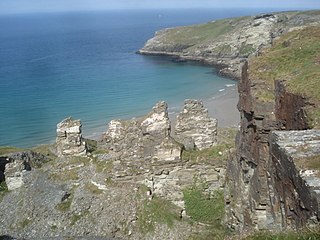
Tintagel Slate Quarries fall into two categories: the series of quarries lying between Tintagel Castle and Trebarwith Strand on the north coast of Cornwall, South West England and the open cast quarries further inland. There are around eight cliff-edge quarries as well as two wharfs, all of which are now disused as well as four inland sites, two of which are still in operation. The first quarry to be worked appears to have been Lanterdan at some point in the fifteenth century, while the last of the coastal quarries, Long Grass ceased operations in 1937. The remains of the coastal quarries occupy coastal land owned by the National Trust and most are easily accessible from the South West Coast Path. The Prince of Wales Quarry has been turned into a country park by North Cornwall District Council.

Hole Beach is a bathing and surf beach just north of Trebarwith Strand on the North Coast of Cornwall, South West England. The beach can be accessed from Trebarwith at low tide or by a zigzagging quarryman's track from the village of Treknow. The beach is sandy and the water is good for surfing. The sheer cliffs to the north of the beach form part of the now disused Caroline Slate Quarry and were created by quarrymen suspended by ropes attached to strongpoints some 75m on the clifftop above. A cave 15m above sea level is artificial and is also the result of quarrying- this is the "hole" that gives the beach its name. There is also a natural sea cave at the rear of the beach. One of the stone strong points still perches on top of the near vertical cliffs 75m above the beach, as does a second building which was possibly used as a toolshed.
The Prince of Wales Quarry is a disused open cast slate quarry in Trebarwith Valley on the outskirts of Tintagel in Cornwall, South West England. The quarry is known for its engine house, the only one of its kind in North Cornwall.

Lanterdan Quarry is a disused open cast slate quarry between Tintagel and Trebarwith on the north coast of Cornwall, South West England. The quarry is the oldest, largest and most spectacular of Tintagel’s coastal quarries and was worked from the fifteenth until the early twentieth century. A distinguishing feature of the quarry is a 25m high pinnacle of inferior slate.

West Quarry is a disused open cast slate quarry between Tintagel and Trebarwith on the north coast of Cornwall, South West England. The quarry ceased operations towards the end of the nineteenth century.
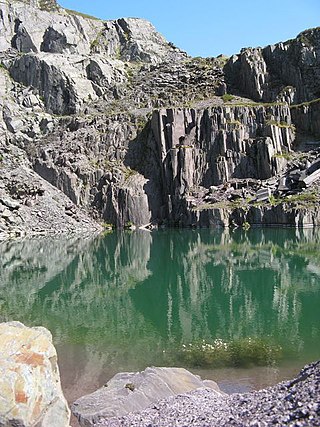
Alexandra quarry was a slate quarry in North Wales, on the slopes of Moel Tryfan in north Gwynedd. It was part of one of the major slate quarrying regions of Wales, centred on the Nantlle Valley during the 19th and 20th centuries. Output increased when a connection to the North Wales Narrow Gauge Railways branch to Bryngwyn was created. It closed in the late 1930s, but was subsequently amalgamated with the Moel Tryfan quarry, and production continued until the 1960s.